Into the Heart of Ethiopia
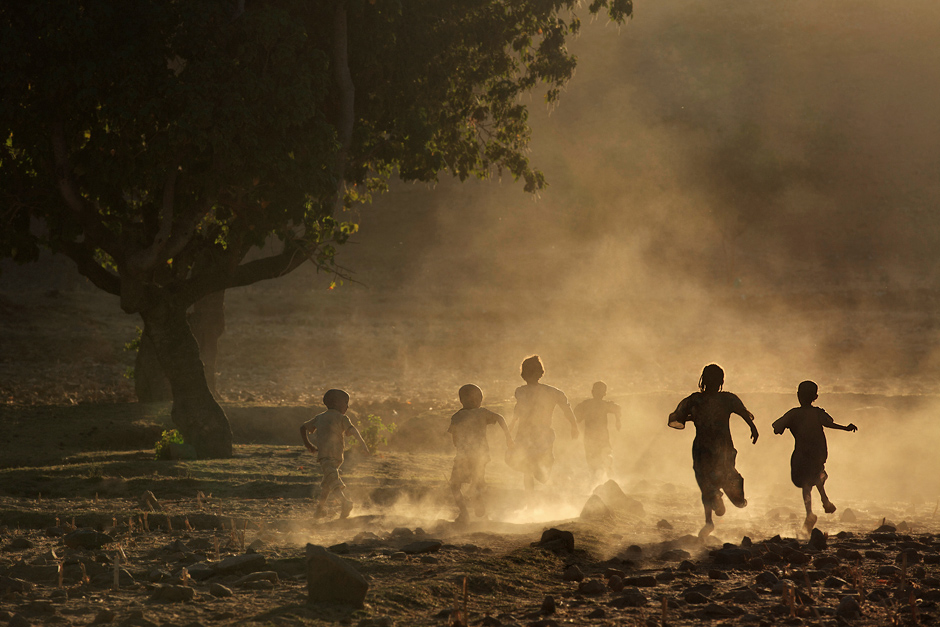 Dramatic landscapes, kind, warm people and photographic inspiration at every corner - this was my romanticized vision of Ethiopia. Perhaps this vision was what made me all the more disappointed and emotionally deflated, when for over a month I came across more rudeness, dishonesty and overall strange treatment than anywhere else I had traveled. It took time and a lot of luck to meet the right people, to finally find the Ethiopia I dreamt of, but I have found it and, it is A-m-a-z-i-ng! I'll give you a bit of a background story to put things in perspective and then, to the photos.
Dramatic landscapes, kind, warm people and photographic inspiration at every corner - this was my romanticized vision of Ethiopia. Perhaps this vision was what made me all the more disappointed and emotionally deflated, when for over a month I came across more rudeness, dishonesty and overall strange treatment than anywhere else I had traveled. It took time and a lot of luck to meet the right people, to finally find the Ethiopia I dreamt of, but I have found it and, it is A-m-a-z-i-ng! I'll give you a bit of a background story to put things in perspective and then, to the photos.
Ethiopia, up to a bit more than a month ago was the most challenging country I'd traveled. For one simple reason - I stopped feeling human when interacting with most of the locals. When virtually every child on the street meets you with an outstretched hand and a demanding look, when every conversation leads to money that you should give - you start to feel a little weird, to say the least.
Then at the beginning of last month two things happened - we came to Mekele - a student town in the Northern Ethiopian province of Tigray and, we met Zemenfes - a young man who was to be my guide/translator, but has turned into a younger brother (who needs an occasional butt-kicking, but who's always there for you). It's funny how one's fortunes can change so quickly, when you're with the "right" people and in the "right" place.
As I was flying into Mekele after a quick trip to Addis (to renew my visa) I saw villages in the mountains, scattered far away from each other, seemingly in the middle of nowhere, nothing but occasional, barely visible dirt-tracks connecting them to the rest of the world. These villages, I realized were where the Ethiopia I was looking for was. Such places were where we ended up over the last few days. Whether they are indeed the heart of Ethiopia is of course questionable, but I certainly hope so. I hope that before all the money demands, all the overcharging on various transactions, all the dishonest guilt-tripping, those people were also "pure" - honest, full of dignity, just like the people I met recently.
Ok, enough of that, I'll let the photos tell the rest of the story. Remember, you can always click on the image to see a larger version of it.
 Our first trip with Zemenfes was to an area called Abi Adi - a fairly isolated region in South West Tigray. Churches, lots of them made of rock, are omnipresent throughout the region and there was a particularly awesome church called "Abba Yohani" that I wanted to see in this area. We did, first riding to it after sunset to see where it is located, then riding to it again at 4am, as that's when the mass was held.
Our first trip with Zemenfes was to an area called Abi Adi - a fairly isolated region in South West Tigray. Churches, lots of them made of rock, are omnipresent throughout the region and there was a particularly awesome church called "Abba Yohani" that I wanted to see in this area. We did, first riding to it after sunset to see where it is located, then riding to it again at 4am, as that's when the mass was held.
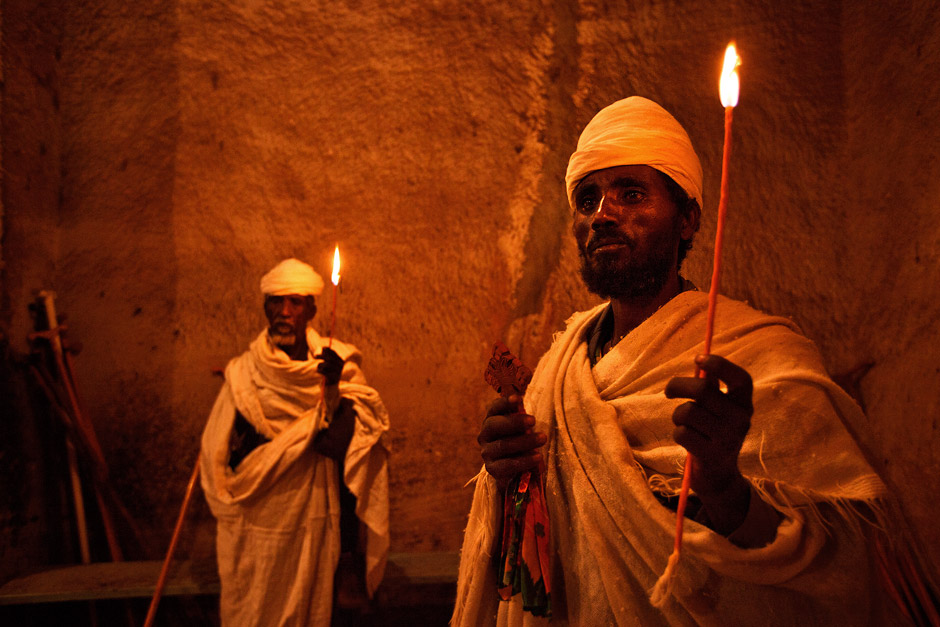 My new friend made a suggestion that we should gift the church a few candles, if we wanted to be seen as something more than regular tourists (not that more than a few come here every year). I of course love shooting in candle light, so he got no arguments from me. :) There's light from a few little lamps here too, the candles are used less for lighting, more for ceremonial purposes. The priests did very much appreciate the gift and said that no other foreigners had ever gifted them culturally relevant things like that before.
My new friend made a suggestion that we should gift the church a few candles, if we wanted to be seen as something more than regular tourists (not that more than a few come here every year). I of course love shooting in candle light, so he got no arguments from me. :) There's light from a few little lamps here too, the candles are used less for lighting, more for ceremonial purposes. The priests did very much appreciate the gift and said that no other foreigners had ever gifted them culturally relevant things like that before.
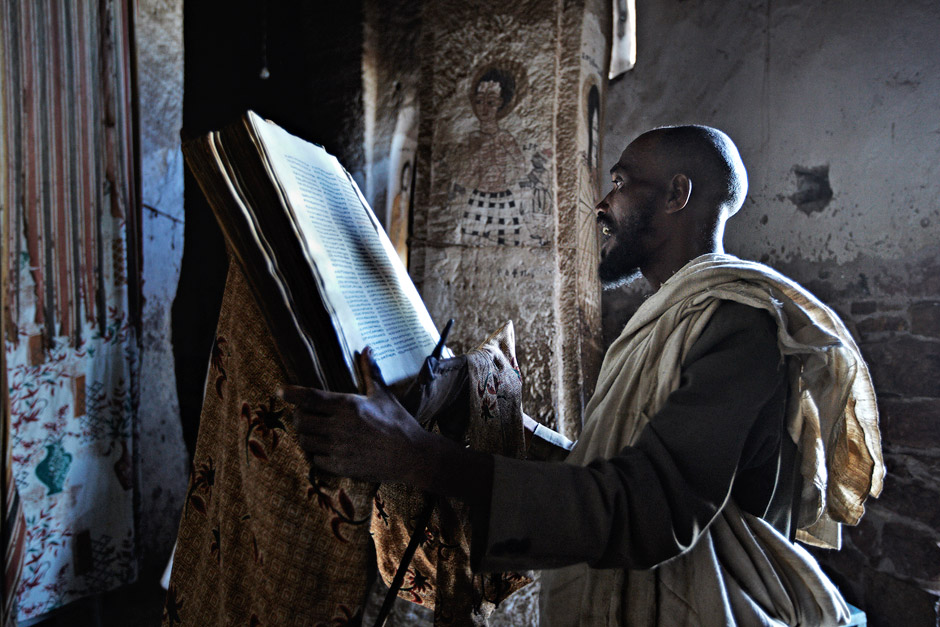 It was refreshing not to have to deal with the crap that we dealt with in the more visited churches - a tip for the "key boy" a tip for the priest, a tip to take a breath - you get the point. Here, the folks were genuine, really into their faith and, they were hospitable and friendly. I could take photos wherever I wanted to, as long as I did it with respect for the ceremony.
It was refreshing not to have to deal with the crap that we dealt with in the more visited churches - a tip for the "key boy" a tip for the priest, a tip to take a breath - you get the point. Here, the folks were genuine, really into their faith and, they were hospitable and friendly. I could take photos wherever I wanted to, as long as I did it with respect for the ceremony.
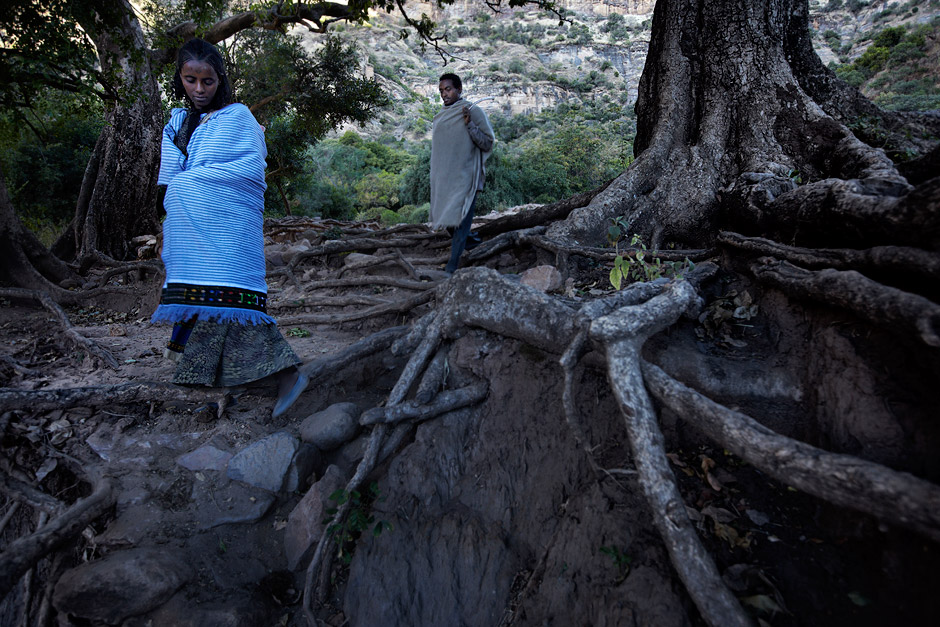 I was told that there's supposed to be a "green area" around all the churches, a mini-forest of sorts. While this isn't really the case in the drier regions, there was a beautiful little patch of trees and bush that surrounded Abba Yohani and a neighbouring church, to which we went with the hopes of seeing a christening, but were too late.
I was told that there's supposed to be a "green area" around all the churches, a mini-forest of sorts. While this isn't really the case in the drier regions, there was a beautiful little patch of trees and bush that surrounded Abba Yohani and a neighbouring church, to which we went with the hopes of seeing a christening, but were too late.
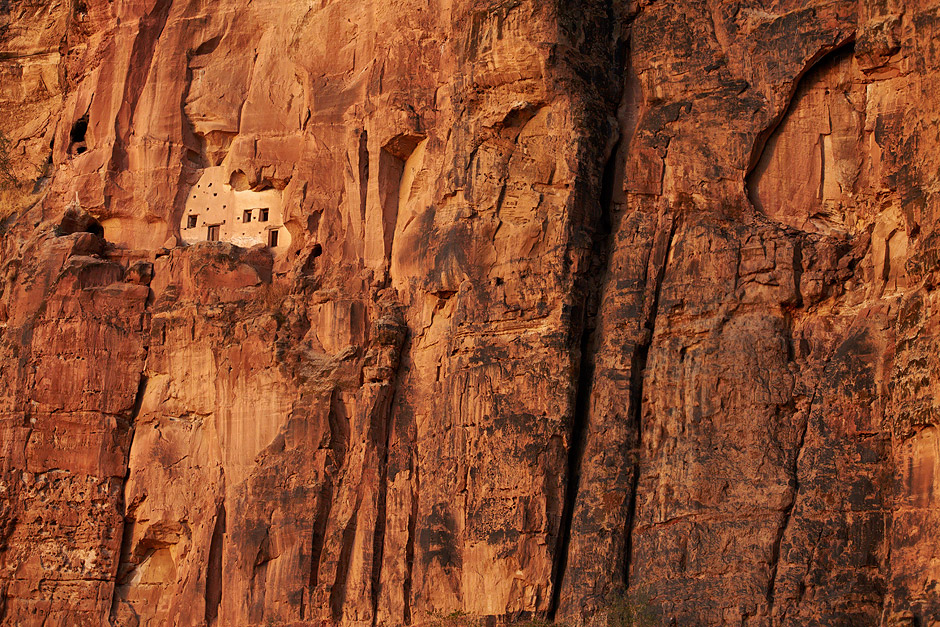 The view of Abba Yohani church from the outside is pretty spectacular. When I first saw a photo similar to this one in the "Bradt Guidebook to Ethiopia", I was pretty compelled to visit. To get the kind of photo that I wanted, I returned closer to sunset and waited for the sun to cast its orange light on the rock surface.
The view of Abba Yohani church from the outside is pretty spectacular. When I first saw a photo similar to this one in the "Bradt Guidebook to Ethiopia", I was pretty compelled to visit. To get the kind of photo that I wanted, I returned closer to sunset and waited for the sun to cast its orange light on the rock surface.
 The news of a foreigner with a motorbike photographing the church spread quickly. A priest who we had met, but not really seen the previous night turned up to greet me and Zemenfes. He was pretty photogenic and very willing to be in the photo, so, I said - why not?
The news of a foreigner with a motorbike photographing the church spread quickly. A priest who we had met, but not really seen the previous night turned up to greet me and Zemenfes. He was pretty photogenic and very willing to be in the photo, so, I said - why not?
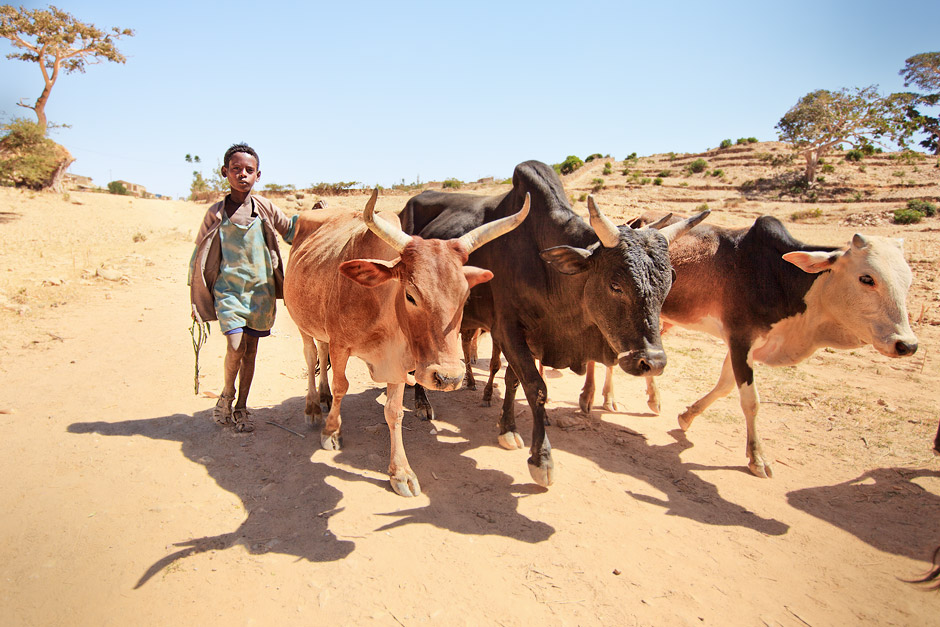 Of course the area is not all about churches. After photographing in and around Abba Yohani, we had a special day with Wurko - a young shepherd boy we met along the road (the dusty one). He turned out to be a wonderful fellow. Even children are hospitable in this area. Wurko offered us beans from his family's garden and showed us around his village.
Of course the area is not all about churches. After photographing in and around Abba Yohani, we had a special day with Wurko - a young shepherd boy we met along the road (the dusty one). He turned out to be a wonderful fellow. Even children are hospitable in this area. Wurko offered us beans from his family's garden and showed us around his village.
One of the coolest things Wurko showed us was the family tree house. It was the place where guests slept and it was here that he spent most of his time when the crops needed to be guarded from birds and other "pests". In this image Wurko is pointing out an escaped cow to the kids below.
After our time with Wurko, Zemenfes and I decided to just keep riding along the road, to see where it takes us. A few kilometers later we came across a very traditional looking house. I wanted to check it out. Inside we found an elderly man, aged close to 90. He was a leather worker and used to be relatively rich in his youth. His abilities and the demand for leather is no longer the same, but he does still work. Here he is making a baby harness, for which there is still some demand in the areas that are deep in the countryside.
 We asked the man if we can see around the house and we soon came across his daughter in law and her child. As you can see, the traditional houses are built of stone.
We asked the man if we can see around the house and we soon came across his daughter in law and her child. As you can see, the traditional houses are built of stone.
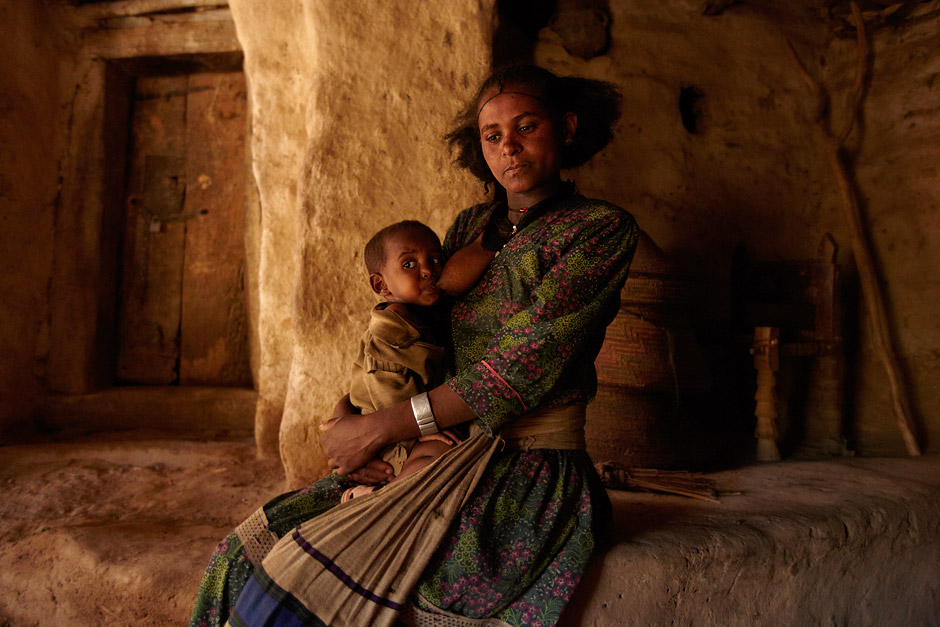 The woman went into the house to breast-feed her child. It took me a little by surprise (coming from the "west") that there was no shyness about the process, none of the stigma that I might have expected from a conservative society, especially when taking a photo. It was just a natural, human process - a mother doing what a mother is supposed to do - breast feed her child.
The woman went into the house to breast-feed her child. It took me a little by surprise (coming from the "west") that there was no shyness about the process, none of the stigma that I might have expected from a conservative society, especially when taking a photo. It was just a natural, human process - a mother doing what a mother is supposed to do - breast feed her child.
 I had really wanted to see inside the traditional kitchen and we asked if the woman was planning to cook anything. She wasn't, but being incredibly hospitable she cooked some dried beans, which are a common snack around the area, and fed them to us.
I had really wanted to see inside the traditional kitchen and we asked if the woman was planning to cook anything. She wasn't, but being incredibly hospitable she cooked some dried beans, which are a common snack around the area, and fed them to us.
 There's plenty of beauty and drama in the landscapes around Abi Adi, one just has to get on a motorcycle (or into a car) and explore. This is exactly what I did closer to sunset.
There's plenty of beauty and drama in the landscapes around Abi Adi, one just has to get on a motorcycle (or into a car) and explore. This is exactly what I did closer to sunset.
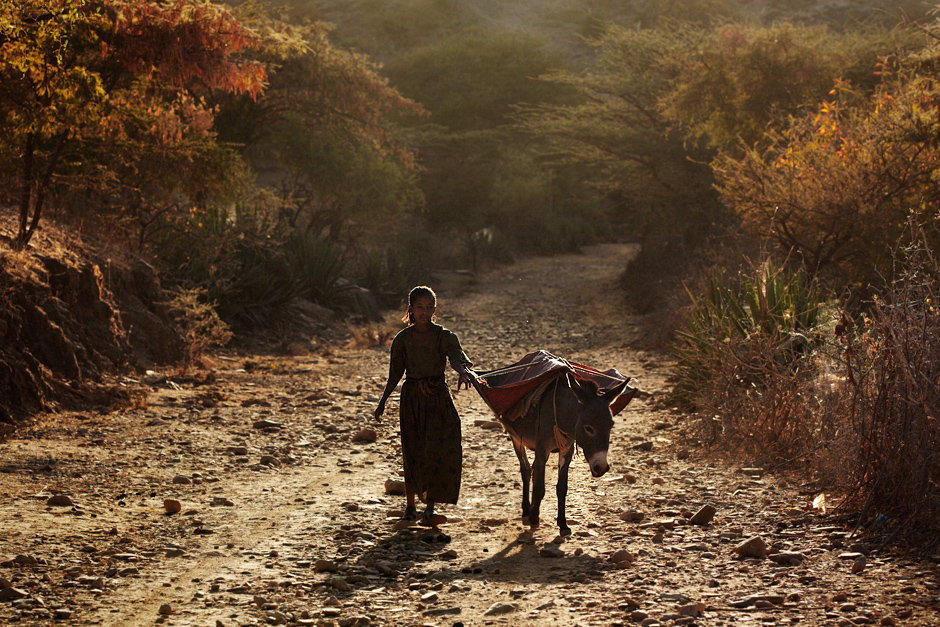 Just a few hundred meters from the landscape in the photo before this one I found this scene, which is very common around rural Ethiopia. It is estimated that Ethiopia has millions of donkeys and their jobs vary from carrying water containers from the well or a waterpump, to carrying less mobile people up hills.
Just a few hundred meters from the landscape in the photo before this one I found this scene, which is very common around rural Ethiopia. It is estimated that Ethiopia has millions of donkeys and their jobs vary from carrying water containers from the well or a waterpump, to carrying less mobile people up hills.
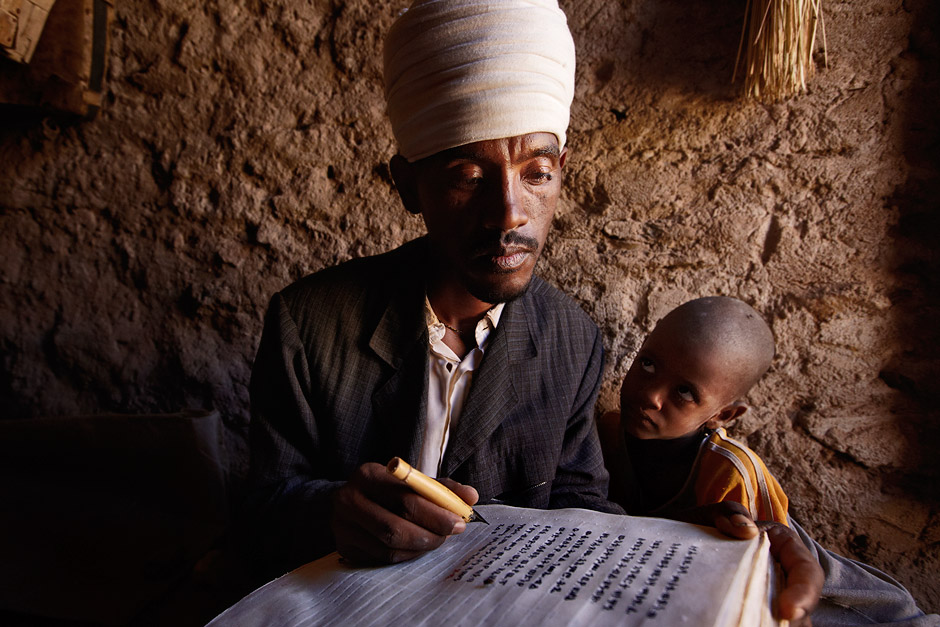 Mosei (Moses) is a priest, but not just a regular priest. He is one of very few people in his area who can write holy texts for the mass. The texts are not written on paper, but rather on goat skin because it can last "forever" as Mosei says. We met him just before we were about to leave Abi Adi. I'm sure there are plenty more fascinating subjects in the area. Perhaps another time I will explore them too.
Mosei (Moses) is a priest, but not just a regular priest. He is one of very few people in his area who can write holy texts for the mass. The texts are not written on paper, but rather on goat skin because it can last "forever" as Mosei says. We met him just before we were about to leave Abi Adi. I'm sure there are plenty more fascinating subjects in the area. Perhaps another time I will explore them too.
 In an area South of the city of Mekele, we traveled along a ridiculously bad roads towards an isolated monastery in the mountains. There we met a nun who's name translated to mean something like "The daughter of a thousand" or in other words someone who everyone wants to have as their daughter. Like many folks who end up at monasteries, she had a sad story. Her husband and children are all dead, she didn't want to talk about the details. I asked whether she found some inner peace away from the the "real" world in the monastery - "Yes. I am at peace now." Was her reply.
In an area South of the city of Mekele, we traveled along a ridiculously bad roads towards an isolated monastery in the mountains. There we met a nun who's name translated to mean something like "The daughter of a thousand" or in other words someone who everyone wants to have as their daughter. Like many folks who end up at monasteries, she had a sad story. Her husband and children are all dead, she didn't want to talk about the details. I asked whether she found some inner peace away from the the "real" world in the monastery - "Yes. I am at peace now." Was her reply.
 One of my plans was to photograph exorcism in a remote mountain village in an area called "Inderta" (around Mekele). To get to the village, we'd need to leave the motorbikes (now there are two) in another village next to what can vaguely be described as a road, and hike up into the mountains with a donkey. Because Ethiopians are quite fond of everything beaurocratic, we also needed a paper that basically said "These guys are ok, please assist them" from the head of all the villages in the district.
One of my plans was to photograph exorcism in a remote mountain village in an area called "Inderta" (around Mekele). To get to the village, we'd need to leave the motorbikes (now there are two) in another village next to what can vaguely be described as a road, and hike up into the mountains with a donkey. Because Ethiopians are quite fond of everything beaurocratic, we also needed a paper that basically said "These guys are ok, please assist them" from the head of all the villages in the district.
We found the head of the district who, like most people in Inderta, turned out to be incredibly helpful and hospitable. The only problem was that is was late in the day and ended up having to stay at his home. This is a photo of his wife and daughter preparing stew. The seldom used flash in a softbox was placed off camera to help me light this shot.
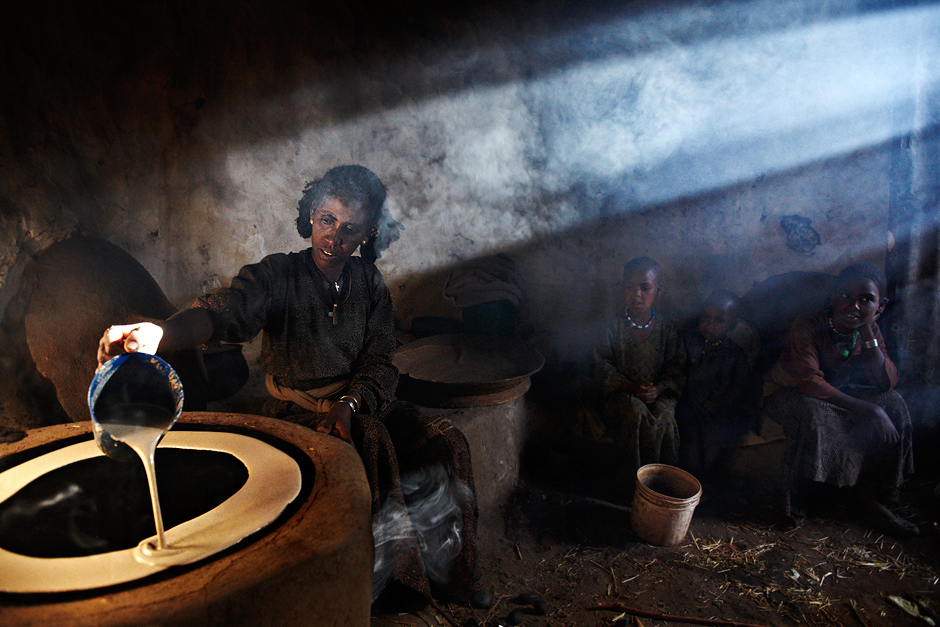 With the letter in hand we went to the "Exorcism village", but, the "head exorcist" said it wasn't good enough. No matter what letter we had, nor how much money we had, we weren't allowed to even attend the exorcism and certainly not to photograph it. We needed to be Orthodox and while Tanya and I are actually Russian Orthodox by default, we aren't exactly religious, hence, I felt it was pointless trying to convince the guy to let us do what we wanted.
With the letter in hand we went to the "Exorcism village", but, the "head exorcist" said it wasn't good enough. No matter what letter we had, nor how much money we had, we weren't allowed to even attend the exorcism and certainly not to photograph it. We needed to be Orthodox and while Tanya and I are actually Russian Orthodox by default, we aren't exactly religious, hence, I felt it was pointless trying to convince the guy to let us do what we wanted.
While such an outcome was disappointing, I also admired the fact that the man stood by his principles and wasn't solely interested in getting paid, as so many of his "colleagues" are in other parts of Tigray. Not wanting to return to the (lower) lands of Inderta just yet, we stayed a day and a half. I got to photograph in more traditional Ethiopian kitchens then I'd dreamt possible. This woman immediately invited us to her house for some bread and stew, just out of hospitality, because we were guests. The same act was repeated by numerous other families.
 The "exorcism village" is known for being ridiculously windy and cold in the mornings. It's beautiful, yet rugged and not the ideal place to live, if you like warmth.
The "exorcism village" is known for being ridiculously windy and cold in the mornings. It's beautiful, yet rugged and not the ideal place to live, if you like warmth.
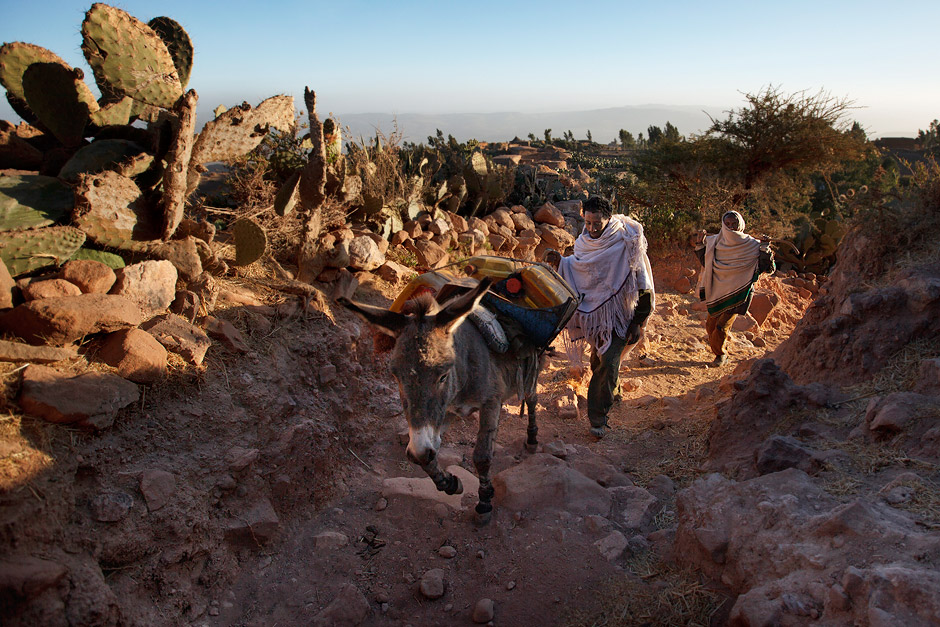 As is the case with so many rural Ethiopian settlements, donkeys are used to bring water from the water pump. It appears that water is relatively scarce around this place because one of the water pumps was locked to a chain and only opened for special reasons.
As is the case with so many rural Ethiopian settlements, donkeys are used to bring water from the water pump. It appears that water is relatively scarce around this place because one of the water pumps was locked to a chain and only opened for special reasons.
There isn't much greenery around most of Inderta, so coming to the mountains village was a bit like coming to a green oasis in the middle of the desert. With nothing but traditional houses and greenery, the place is incredibly photogenic.
 Most of the life for the children around Inderta revolves around house chores. They help the parents feed the cattle, clean the house, get firewood etc. In this photo one sister passes on hay for the cattle to another.
Most of the life for the children around Inderta revolves around house chores. They help the parents feed the cattle, clean the house, get firewood etc. In this photo one sister passes on hay for the cattle to another.
 It should come as no surprise that the financial situation on villages like this one is measured by the amount of cattle a household has. The cattle are a precious"commodity" and must be taken care of regularly.
It should come as no surprise that the financial situation on villages like this one is measured by the amount of cattle a household has. The cattle are a precious"commodity" and must be taken care of regularly.
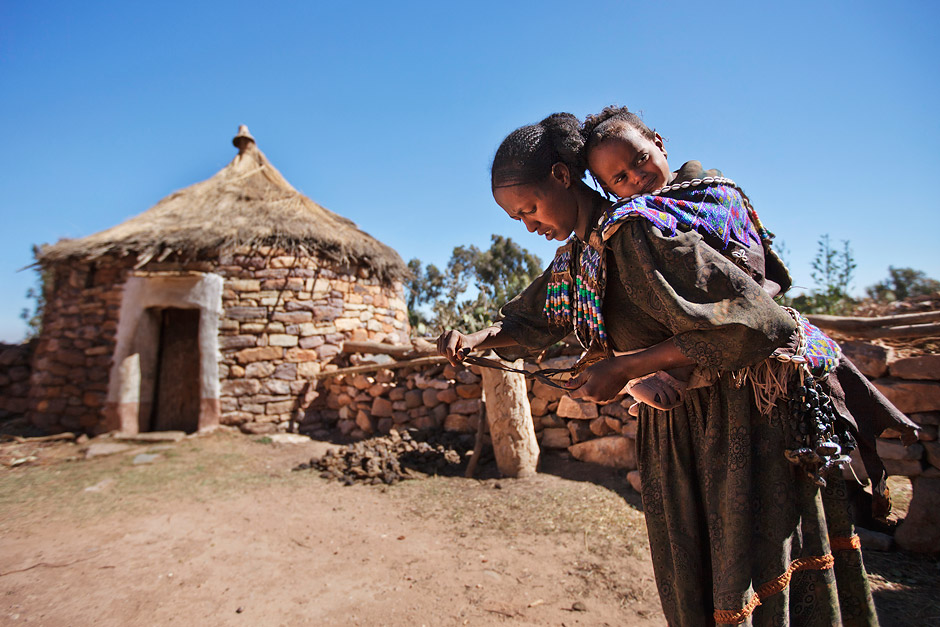 There aren't many places where you can still see mothers using traditional harnesses to transport their young ones. Inderta is one of those places.
There aren't many places where you can still see mothers using traditional harnesses to transport their young ones. Inderta is one of those places.
 As I mentioned, I visited my share of traditional Ethiopian kitchens. We were either fed or offered coffee for the duration of our stay. So much for my idea of losing weight by not eating much in the countryside. These folks just kept feeding us!
As I mentioned, I visited my share of traditional Ethiopian kitchens. We were either fed or offered coffee for the duration of our stay. So much for my idea of losing weight by not eating much in the countryside. These folks just kept feeding us!
 Another family met - another invitation for coffee. The interesting thing about this case was the grandmother. She used to be a merchant in Addis. When Zemenfes asked what she sold, another family member replied - contraband. She seemed like a pretty outgoing and very humorous woman and, kept wanted to marry off Zemenfes to one of her granddaughters.
Another family met - another invitation for coffee. The interesting thing about this case was the grandmother. She used to be a merchant in Addis. When Zemenfes asked what she sold, another family member replied - contraband. She seemed like a pretty outgoing and very humorous woman and, kept wanted to marry off Zemenfes to one of her granddaughters.
 We noticed that the parents of the area are particularly good with their children and I guess, as a result, the children are some of the best kids you can encounter anywhere in the world. They might be a little mischievous at times, but when a child of four offers you a piece of cloth to sit on so you don't dirty your pants by seating on the groung, you know that the parents did something right.
We noticed that the parents of the area are particularly good with their children and I guess, as a result, the children are some of the best kids you can encounter anywhere in the world. They might be a little mischievous at times, but when a child of four offers you a piece of cloth to sit on so you don't dirty your pants by seating on the groung, you know that the parents did something right.
 It was a little sad to leave the "exorcism village" in the mountains, but our next stop would be the village of the district head, which seemed equally hospitable. As you can see, it's not bad looking either.
It was a little sad to leave the "exorcism village" in the mountains, but our next stop would be the village of the district head, which seemed equally hospitable. As you can see, it's not bad looking either.
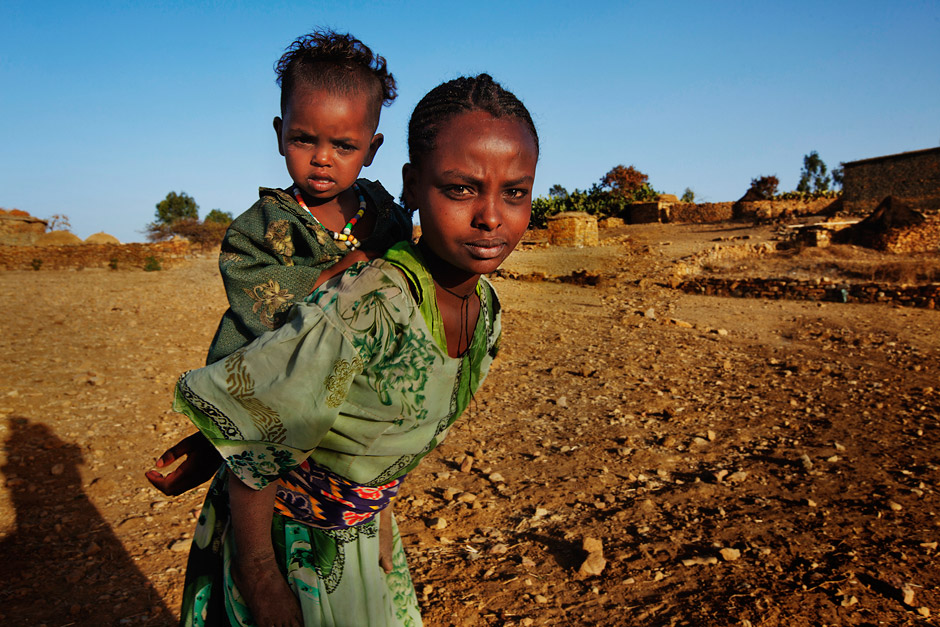 We soon found out that foreigners or at least white foreigners (there are occasional Chinese road workers in Ethiopian countryside) had never visited either of the villages. The result - nearly the entire population gathers around and watches virtually your every move. This can play in your favour, if you're a photographer, as a lot of potential "models" come to you without you having to look for them. That was exactly the case with this image.
We soon found out that foreigners or at least white foreigners (there are occasional Chinese road workers in Ethiopian countryside) had never visited either of the villages. The result - nearly the entire population gathers around and watches virtually your every move. This can play in your favour, if you're a photographer, as a lot of potential "models" come to you without you having to look for them. That was exactly the case with this image.
 Tigrayan woman collecting hay to feed her cattle. The whole region of Inderta is blessed with some very beautiful scenery.
Tigrayan woman collecting hay to feed her cattle. The whole region of Inderta is blessed with some very beautiful scenery.
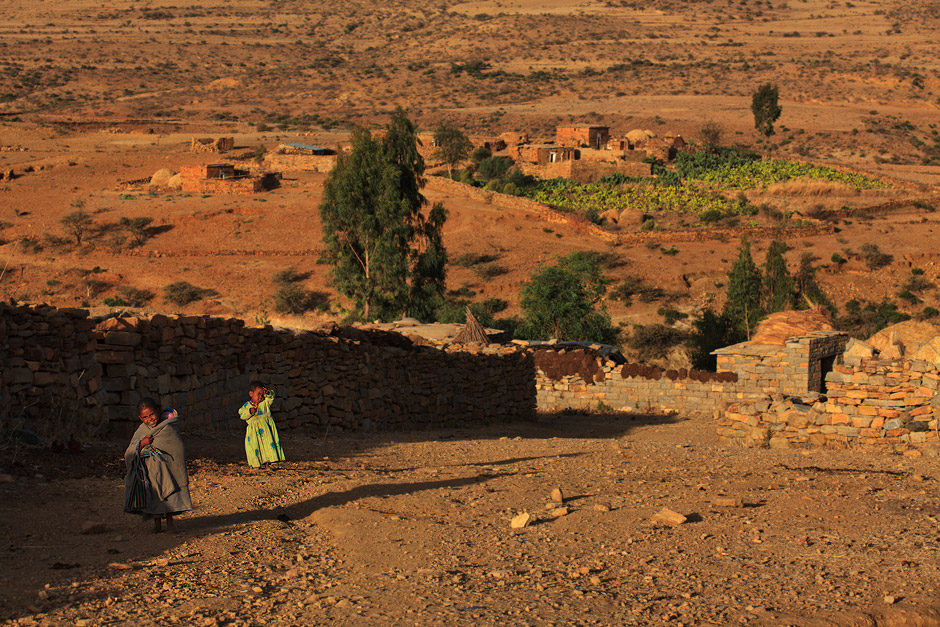 Village children walking along the "street". There's no motorized transport in the village, nor is there electricity, nor running water. Regardless, people who live here are some of the happiest I've come across. I'd be oversimplifying the matter if I were to say that the poorest folks are the ones who are usually happiest, but it is often the case. Modern day amenities will come here one day and I'm sure that a lot of positive things will follow, but I am also almost sure that a lot of the innocence and the warmth will be gone when television arrives. A proper road may very well bring tourist vehicles with people throwing around candy, pens and whatever other crap and then, well, I'd like to hope that day is still far away.
Village children walking along the "street". There's no motorized transport in the village, nor is there electricity, nor running water. Regardless, people who live here are some of the happiest I've come across. I'd be oversimplifying the matter if I were to say that the poorest folks are the ones who are usually happiest, but it is often the case. Modern day amenities will come here one day and I'm sure that a lot of positive things will follow, but I am also almost sure that a lot of the innocence and the warmth will be gone when television arrives. A proper road may very well bring tourist vehicles with people throwing around candy, pens and whatever other crap and then, well, I'd like to hope that day is still far away.
 Children in tourist areas run at you demanding things. Children in villages which had never been visited by foreigners approach you carefully. They've heard about you from their neighbours, but they still don't know what to expect. Above is a typical scene - curious kids peeking through the door, to see what all the fuss is about.
Children in tourist areas run at you demanding things. Children in villages which had never been visited by foreigners approach you carefully. They've heard about you from their neighbours, but they still don't know what to expect. Above is a typical scene - curious kids peeking through the door, to see what all the fuss is about.
 It seemed that every house wanted to have us as guests and then at one of these houses, we learned that there would be a christening of a young boy the next day. We decided to ride back to Mekele for a few hours (to recharge batteries and dump all the images onto a harddrive) and come back for the evening and next day's christening. A lot of injeras were to be cooked and in the image above children are collecting firewood to keep the cooking fire going.
It seemed that every house wanted to have us as guests and then at one of these houses, we learned that there would be a christening of a young boy the next day. We decided to ride back to Mekele for a few hours (to recharge batteries and dump all the images onto a harddrive) and come back for the evening and next day's christening. A lot of injeras were to be cooked and in the image above children are collecting firewood to keep the cooking fire going.
 The christening of a child is a BIG deal for Ethiopian Orthodox Christians. The mother gets her hair done before the big day, while feeding her soon-to-be christened son.
The christening of a child is a BIG deal for Ethiopian Orthodox Christians. The mother gets her hair done before the big day, while feeding her soon-to-be christened son.
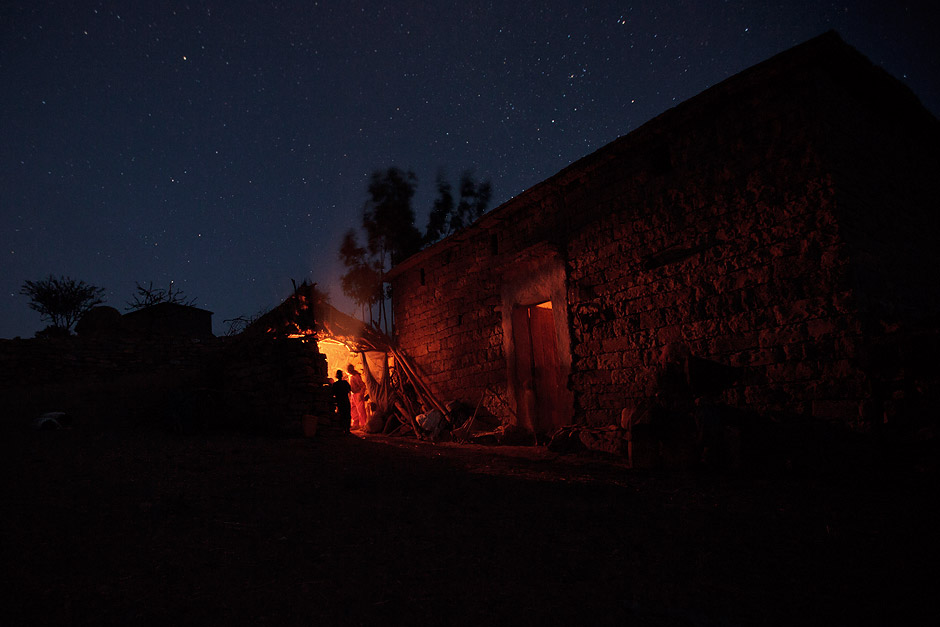 Preparations continue for the entire night, with different women taking turns at making the injera for dozens of guests who will come the next day.
Preparations continue for the entire night, with different women taking turns at making the injera for dozens of guests who will come the next day.
 It was a true privilege to hang out with the family and to be allowed to photograph them in various intimate aspects of their everyday lives. While we were having our very late dinner, one of the younger kids had a nightmare and had to be comforted by the mother.
It was a true privilege to hang out with the family and to be allowed to photograph them in various intimate aspects of their everyday lives. While we were having our very late dinner, one of the younger kids had a nightmare and had to be comforted by the mother.
 Photographically, the problem with christenings is that they usually occur in a small part of the church, only large enough for a couple of people. Of course, these little rooms get crammed with more than a couple of people and this makes the photographic process all the more difficult. On the positive side of things, because we had already become friends with the family, it didn't feel so awkward making my way through to get a better angle.
Photographically, the problem with christenings is that they usually occur in a small part of the church, only large enough for a couple of people. Of course, these little rooms get crammed with more than a couple of people and this makes the photographic process all the more difficult. On the positive side of things, because we had already become friends with the family, it didn't feel so awkward making my way through to get a better angle.
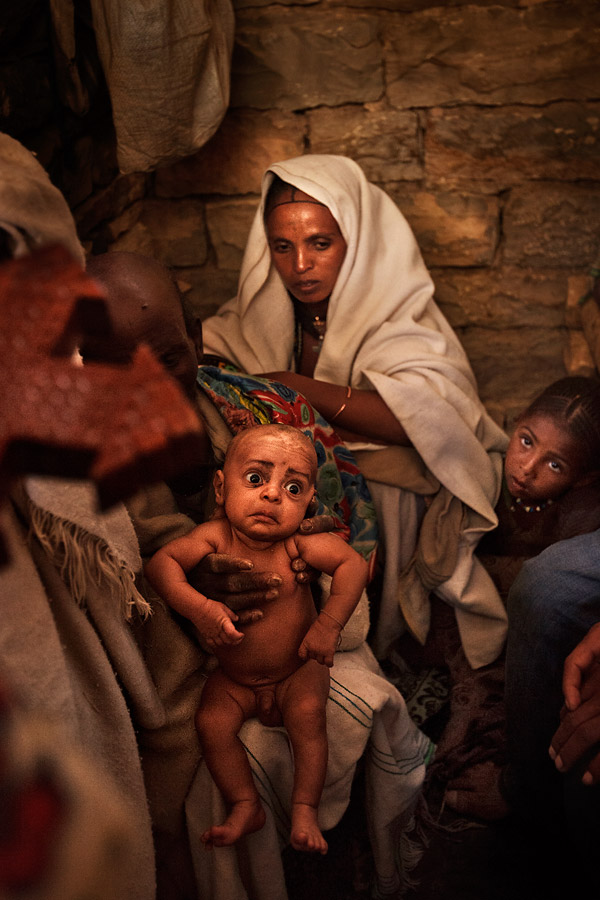 And so, the big moment comes. The baby is of course completely clueless and totally freaked out, but such is the tradition.
And so, the big moment comes. The baby is of course completely clueless and totally freaked out, but such is the tradition.
 With a few splashes of the holy water, the baby is baptized and is now a christian. We were given the honour of naming the child. I wasn't initially sure if they were for real, but it seemed that they were, as they kept referring to the boy as Samson - the name that we decided to give him. :)
With a few splashes of the holy water, the baby is baptized and is now a christian. We were given the honour of naming the child. I wasn't initially sure if they were for real, but it seemed that they were, as they kept referring to the boy as Samson - the name that we decided to give him. :)
I am now in Adigrat, backtracking a little along the road which I used to come to the Southern part of Tigray. I hear that there's an amazing monastery which isn't on the tourist map and that usually means - normal, decent people.
I can't say how privileged and happy I feel to have had the opportunity to see this side of Ethiopia, after almost giving up on the thought that it even existed. It truly sucks that tourism can have such a negative impact on what are potentially some of the world's most special places. All I can say is that I'm damn happy that I decided early on to get my motorcycle with the hopes of getting off the beaten track - tt's paid off big time.


